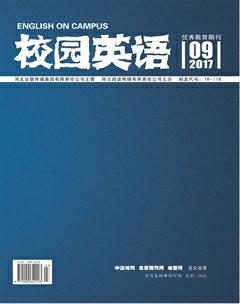《审美不服从》汉译的反思性报告
【摘要】本文是基于《审美不服从》一文节选翻译的反思性研究报告。2016年9月翻译此篇美学文章。文章具有一定的专业性,在翻译中也增加了难度。译文以《冒犯观众》例子出发,简要介绍了审美不服从的特点,阐释其内容。本文共有三章。第一章,译者介绍翻译材料;第二章从句法层面分析原文文本特点,同时从美学角度分析影响译文其它因素。通过分析原文,更好的指导翻译实践。结合具体译例,总结在翻译过程中遇到的困难和难题并提出相应解决方法。其中,目的论以及核心句法作为指导理论,为翻译提供依据。第三章为结尾部分,译者简要反思在此次翻译中的不足,以及通过此次反思和总结提升翻译水平。
【关键词】目的论 《审美不服从》 一词多义 长难句
【Abstract】This thesis is a reflective research report based on the translation of the excerpts of aesthetic disobedience. In September 2016, the translator translated this aesthetic article. The thesis has professional elements so the difficulty is doubled. The translator should have the knowledge of aesthetic so that the discrepancies can be avoided. The excerpt takes Publikumsbeschimpfung as an example and introduces the features of aesthetic disobedience and explains specifically. This thesis consists of three chapters. The translator first introduces the source text in Chapter One. In the Chapter Two, the translator analyzes the characteristics of source text form the perspective of syntax and study other aesthetic factors that influence the target texts. Through analyzing the source text, the translation practice can be guided reasonably. Then, the translator summarizes the main difficulties during the translation such as the translation of long sentences. Related solutions are also provided in this chapter. “Skopos theory” and “kernel sentence theory” are the guidance of the article and provide reasons. The Chapter three is the conclusion. The translator finds some shortcomings and aims at improving the translation skills so as to enhance a higher level.
【Key words】Skopos Theory; Aesthetic Disobedience; polysemy; difficult and long sentences
一、引言
本文簡要介绍审美不服从这一美学原则,并以举例的方式简要阐释这一原则,文中有大量专业术语,在翻译的过程中充分理解原文语境以及术语所表达的意思,才能更加高效地将原文译出。同时,长句以及修饰语众多也是本文一大特色。分析修饰关系以及句子成分成为翻译过程中不可或缺的一部分,也是影响翻译质量的重要因素。
依据不同类型文章,纽马克(2001)将文章分为三类,分别为表达型文本、信息型文本以及呼唤型文本。很显然本文属于信息型文本,旨在将信息传达给读者。
二、反思
长难句处理。
1.核心句法视角下的长难句。奈达将语言分为四大语义范畴,即:物体词、活动词、抽象词和关系词。而且,“四大词类实际上市语言学家所称的语言‘核心成分,它们是语言结构的基本成分”(Tan Zaixi 2002: 123)。“物体词”表示发出动作的人或物。“活动词”表示事物、动作及过程的状态,“抽象词”表示活动、事物以及其他抽象概念的特性、数量和程度。“关系词”则表示另三类词与词之间的关系,与时间、空间和逻辑相关。因此,奈达任务英语所有的句子都可以分解为其中结构的核心句。
汉语中太长的句式较为少见,语义和逻辑关系常通过语序来体现。而英语中长句较多,句法结构的复杂以及自由的语序给英语长句汉译带来很大的阻碍。所以,利用核心句分析法翻译英语长句,除了分析明显的主谓关系,重点还要分析包含逻辑主谓关系的附加成分。英语长难句汉译的困难之处,难在诸多句子间的逻辑关系以及修饰关系,给译句造成困难。
例1:Only public performative engagement with and violation of the norms of theater would sufficiently illustrate the problem and deliberatively engage the theater-going public.
译者将其分解为几个简单句,并将省略部分增补,形成下列句子。
(1) Only public performative engagement with would sufficiently illustrate the problem.
(2) Violation of the norms of theater would sufficiently illustrate the problem.
(3) Only public performative engagement with deliberatively engage the theater-going public.
(4) Violation of the norms of theater deliberatively engage the theater-going public.
由此,可以分析出,“public performative engagement with”及“Violation of the norms of theater ”为并列成分。后面的“illustrate the problem”以及“engage the theater-going public”也为并列成分。逻辑关系、主谓关系以及修饰成分变得明了。
核心句:Performative and violation would illustrate the problem and engage the public.
译文:仅公众参与的表述行为和违背戏剧规范,就足以说明这一问题,同时也具有吸引公众观看演出的作用。
2.长难句中的省略以及成分分析。英汉文化的差异导致硬汉两种语言的巨大差异,这种差异不仅体现在语音以及书写方面,在语法包括句法方面都有所体现。英语属于屈折性语言,这造成了英汉两种语言句法结构的悬殊。汉语不注重形式,句法结构不完备,动词的作用没有英语中那么突出,重意合,轻分析。英语高度形式化、逻辑化,句法结构严谨完备,并以动词为核心,重分析轻意合。英语行文简洁,在句子中为避免重复,常出现省略或代替的形式,其中不免一些省略或以指示代词(it, that, this, those等)来指代前文提到的内容,这也是长句较难理解的原因之一。在翻译时,我们需要对省略的部分进行补充。
例3 So, Publikumsbeschimpfung publicly breaks the norms of the theater while (it is) drawing attention to the conflict between those entrenched, institutionalized norms and broader shared commitments of the participants of theatrical practice in order to promote a change in practice.
这句话中,“while”一词后,因时间状语从句与条件状语从句的主語一致,所以省略主语和助动词,即“it is”。在从句中,“between ... theatrical practice”做“conflict”的定语,而“in order to ... practice” 则是不定式表目的。翻译时,若把“这”一类的词翻译出来则会显得翻译腔略重,为了适应汉语表达习惯,译者在阅读原文时就将省略部分增补出来,以便接下来进行翻译。
译文:所以,《冒犯观众》为了推动实践的改变,在根深蒂固或已成惯例的规范与戏剧实践参与者共享的更加广泛的承诺间引起关注,公然打破了戏剧的规范。
三、结语
通过对材料的翻译实践,译者对翻译理论指导下如何解决困难及问题有了更加深刻的理解,也积累了宝贵的经验。翻译过程中,对于一些陌生词汇不能立刻去查字典,而要首先结合上下文语境,然后分析句子结构,分析其在句中的成分,再对词义做出定夺。翻译时,最突出的障碍就是句法。由于英汉两种语言的差异,导致句子结构相差甚远。结合核心句分析,层层分解句子结构,探寻句子深层次的内在联系,选择合适的语言风格进行表达,提高翻译的可读性,使读者更易于接受。大量阅读相关材料,熟悉作者背景,写作背景,掌握翻译技巧。做到上述,才算得上市一位合格的译员。
参考文献:
[1]纽马克.上海外语教育出版社.翻译问题探讨(Approaches to Translation)[M].上海:上海外语教育出版社,2001:83.
[2]谭载喜.新编奈达论翻译[M].北京:中国对外翻译出版公司,2002.
[3]方梦之.中国译学大辞典[Z].上海:上海教育出版社,2007:165-167.
[4]Talyor J R.Linguistic Categorized:Prototypes in Linguistic Theory[M].Cambridge:Cambridge University Press,1995:99.
作者简介:张沈彤(1994-),女,汉族,辽宁沈阳人,英语翻译硕士在读,研究方向:翻译。

